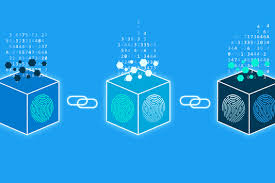 |
| Image Source-Yahoo.com |
Blockchain: The
Scope
Blockchain
is a decentralized and distributed ledger technology. It allows payments in bitcoins to flow through an economy. In fact, it is not only limited to the
finance and banking sector. It is a distributed database. It means that people
who do not know each other or trust each other create a record of facts,
accepted by all. The technology thus opens the door to a new world where
self-enforcing smart contracts replace rules and regulations of the state. This article explains the science behind the technology.
How is
Blockchain implemented?
The
sender initiates the transaction that includes the sending of money from his
wallet. The initiated transaction goes through a series of ledger checks to
ensure that the sender has the requisite amount of money. The transaction while
going through a series of nodes simultaneously moves through a system of
various controls. Once these controls are over, the specialized nodes called miners
come into play. Miners repeatedly, condense all the data about the transaction
to get a string of numbers at last.
After this step, the process implements the hash function to the string
of numbers. It results in the creation of the header of the newly proposed
block. This TEDx Talks video by Douglas Pepe explains beautifully the past, present and future of Blockchain and Crypto.
The
Header
The
header is a part of the mathematical puzzle. The process involves solving the header
by the miners using the hit and trial method.
The solving process includes finding a number called nonce by a miner. Once a nonce is
found, the header traces back to all the miners to confirm the solution. The
confirmation leads to the update of the ledger by adding a new block. The hash
of the header becomes the new block’s identifying string.
Decentralization
The
greatest advantage of this technology is the decentralized system. The copies
of all the blocks are present at all the nodes. Thus all blocks are in the public
zone and available without any third party involvement. It helps in cutting down the extra costs
making the transaction almost free. However, one extra expense involves
rewarding those miners who integrate a new transaction into the blockchain and
confirm the transfer.
Security
Three
important rules guide the puzzle-solving part making the system safe and
secure. The miner or the specialized node resolves the puzzle and update the
block. It makes it impossible to predict. All the blocks have a header
containing the cryptographic hashed information of the previous block. Any
attempted change will result in a new header. Hence, all the following headers
of the blocks will change. If these blocks do not match with the headers of the
existing ones, the system rejects them. The nodes always work on the longest
chain available. Therefore, if the sender changes his mind and decides not to
pay,he will have to lengthen the chain faster than the one caused by the last
initiated transaction of paying the money.
Real
Time
The
entire operation includes the creation of a new block appending the chain. The
time involved in such production is approximately ten minutes. Thus the
transfer of money is almost real-time. The only friction is that the size of
the block reaches the largest size of 1 MB. The network thus can process only
seven transactions per second.
Loopholes
in Security
The
massive group mining effort ensures that “more than 51% control” holds true
against hacking of the system. The shared efforts of the new pools of miners
along with the private dedicated blockchain make it unlikely for any hacker to
hold a significant amount of data to hack the system.
Expanding
Areas
The
concept of blockchain had started with financial institutions making
transactions over money. Its usage is now spreading its roots over anything
that requires stored records and trust. It is now used for completing the
contracts provided the necessary conditions are met. These are also known as
smart contracts. They are programmed such that they are available only under
certain conditions. When these are met the contract automatically gets
implemented, and the profits are also distributed. Both physical and
intellectual property are traded and managed through this system. It is also
used to store personal information regarding identity. A certain amount of
trust should though be established on the miner, who handles storage of the
data.
Internet
of Things
The
internet of things consists of quiet and immobile things like fridges,
doorsteps, and houses. The centralised maintenance of records for such things
is both cumbersome and prone to hacking attacks. Most find it impossible due to the heavy traffic of data. In such scenarios, distributed networks like blockchain
can open various possibilities.
Increased
Power Consumption
As
already said the miners are anonymous and are responsible for solving the
puzzles thereby creating new blocks. Since tracking the miners is next to
impossible, a record of their hardware is also unavailable. Assuming that they
make use of most efficient hardware, it is estimated that an average miner hits
on a trillion solutions every second in the hit and trial method. The energy
consumed therefore is enormous and has produced increasing concerns.
A
Disputed Stand
The
concept of blockchain shall be gradually acceptable. The reason is that systems
without centralized record-keeping are difficult to trust and the confidence
that we lay in the blockchain is on coding rather than accountability and
legitimacy.
The Gist
The world of record-keeping and Distributed Ledger Technology (DLT) that is mathematically immune to manipulation has benefits of its own. These advantages are slow to understand and digest. But once these catch the wildfire, the business world will through a tide of changes. It is therefore beyond doubts that after Personal Computers and the Internet, Blockchain will be next mammoth of technology.
For a detailed understanding please go through
Demystifying Blockchain: The Science Behind the Technology
Blockchain Explained
Blockchain Support Center
Comments
Post a Comment